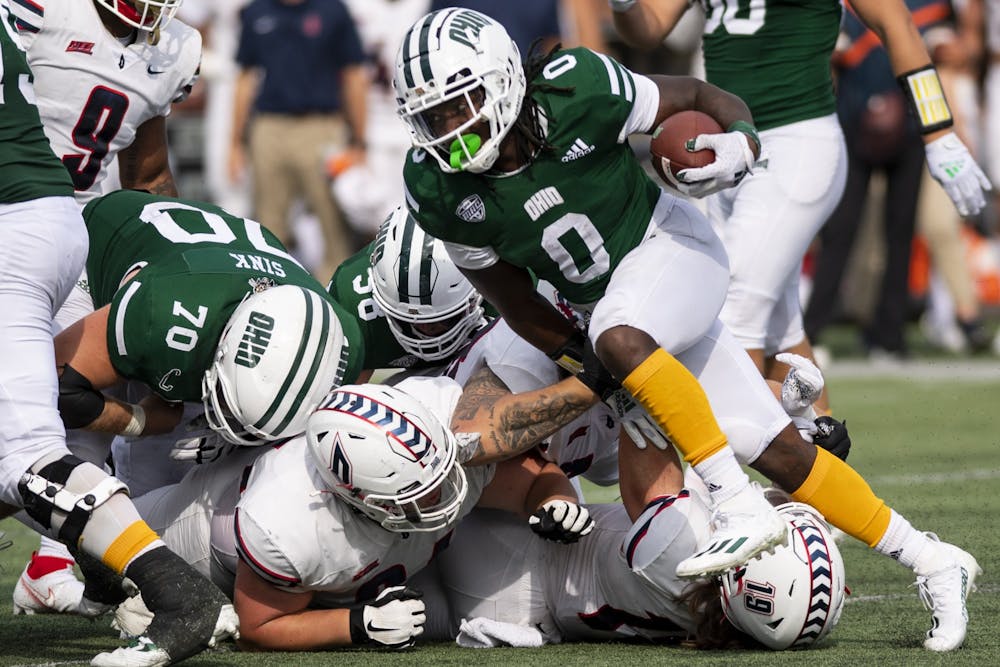LAFAYETTE, La. — Ohio was three yards away from scoring. Down three touchdowns in the third quarter, it clung to the faint hope of mounting a comeback against Louisiana.
Quarterback Kurtis Rourke took the snap and rolled to his right with running back De’Montre Tuggle close behind. He tossed the ball to Tuggle. It was bobbled, dropped and recovered by Louisiana on the 12-yard line.
Ohio jogged back to the sideline, having just extinguished what little hope it had of making a comeback.
A combination of blown opportunities on both sides of the ball resulted in Ohio’s lopsided 49-14 loss to Louisiana Thursday night at Cajun Field.
Ohio’s (0-3) offense continued its trend of inconsistency, and the flashes of success were few and far between. The Bobcats were outgained by the Ragin’ Cajuns (2-1) 562-250 yards.
The defense had just as much trouble, particularly in stopping Louisiana’s run game. Before Thursday, Louisiana’s rushing attack wasn’t anything exceptional, combining for just 166 yards in two games. The Bobcats, however, let the Cajuns run rampant. The Cajuns combined for 312 rushing yards Thursday, almost double their combined total from their games against Nicholls and Texas.
Montrell Johnson scored four touchdowns against the Bobcats. He hadn’t scored in his career prior to Thursday. Johnson and three other Cajuns, including quarterback Levi Lewis, found plenty of open space whenever they ran around the outside. It didn’t help that Ohio’s defense missed multiple tackles throughout the game.
“The fly sweep got outside a couple of times,” coach Tim Albin said. “We lost containment on that.”
The game might’ve been closer, had Ohio’s own run game been up to snuff. For a handful of plays, it was. Quarterback Armani Rogers — known primarily for his rushing abilities — received more time on the field than in Ohio’s first two games. Albin wasn’t afraid to experiment with Rogers on the field. When it paid off, he left Louisiana defenders in the dust, and he combined with the rest of Ohio’s rushers for 103 yards in the first half.
“That was the plan going in,“ Albin said. “We've got to get him more involved, and that was the plan from adjustments or watching last week's film. Coming into the game, we were going to get that done, and we did.”
But Rogers’ — and the rest of Ohio’s running corps — success came to a halt after halftime. The run game received less priority in the final two quarters, and the Bobcats combined for nine yards on the ground as a result.
“In the second half, when the score got where it was,” Albin said. “We were trying to catch up. The running game was plan B. Play-action throwing was plan A. I think the score dictated some of that.”
A struggling offense is an unusual sight for Albin. He’s fostered some of Ohio’s greatest success when he was offensive coordinator under former coach Frank Solich.
But Ohio has struggled to move the ball forward. For the third straight week, it converted on fewer than half of its third downs. It can’t drive the ball down the field when it needs to, and when it does, things often go awry.
“The calls are there,” Albin said. “We’ve got to get points when we’re down there, and we cannot turn it over against a good football team.”
O’Shaan Allison was the Bobcats’ primary rusher for the second straight week, and he finished with 48 yards on 11 carries. With the Bobcats combining for 112 rushing yards Thursday, Allison felt unsatisfied with his own performance and felt there was room for improvement.
“I’ve just got to read my keys better,“ Allison said. “There were a few times where I missed a cutback, just stayed frontside. It was a few mistakes throughout the game that could’ve changed the outcome.”
Going forward, it will be a matter of Ohio fixing the small mistakes. It’s proven that its offense has the talent to drive deep into enemy territory, and its defense can make crucial stops. To win, however, it can’t fumble three yards away from the end zone.






